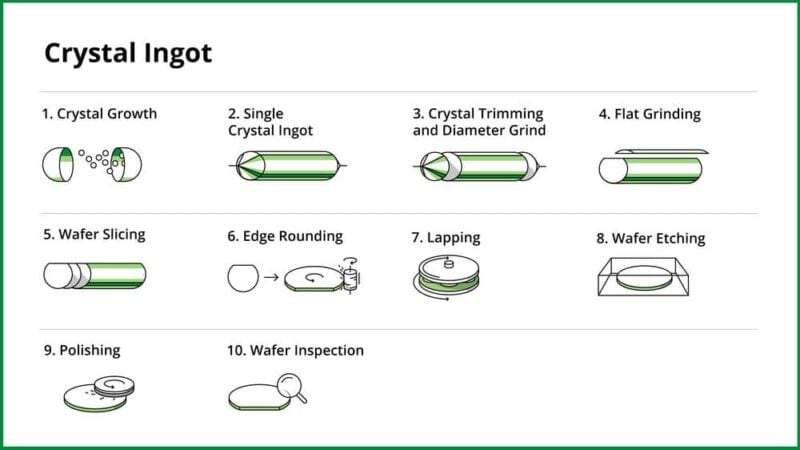The Complete Guide to How LED Lights are Made
LED Lights – What Are They and How Do They Work?
LED lights are currently the best and most energy-efficient lighting systems available. Because of this, all other types of lighting are being phased out around the world because they can’t compare to their quality of light and longer lifespan. LEDs emit light when electrons pass through a semiconductor material. LEDs are made into various types of lighting products. These products include light fixtures, light bulbs, indicator lights, flashlights, automobile headlights, and other types of applications.
The Difference Between LED Lights and Traditional Lights
Traditional lighting creates light by attaching wires to a source of energy. When these wires are heated up, they produce light. LEDs create light by electronic excitation as opposed to heat. Therefore, LEDs use less energy and emit less heat.
LED Light Construction
LED lights consist of a small chip with layers of semiconductor material. LED packages contain one or more chips that are mounted on a heat-conducting material known as a heat sink which is covered by a lens. The LEDs are placed on a circuit board that can be programmed to incorporate lighting controls. These include light sensing, dimming, and pre-set timing. They can also include the number of LEDs used and the running voltage. The circuit board is positioned on an additional heat sink so that the LEDs’ heat is regulated. Everything is then seaLED inside a lighting fixture, an architectural structure, or a light bulb.
How an LED Light Works
Diodes are made from semiconductor material. This semiconductor material is composed of crystalline material and requires impurities to conduct electricity. These impurities are added to the semiconductor material later in the manufacturing process. One of the layers of semiconductor material will have a surplus of electrons, and the other layer will be depleted of electrons. The disparity in electron levels allows them to move from one layer to the next. This creates light via electronic excitation.
How are LED Lights Made? – The Production Process of LED Lights
Design Stage
Before manufacturing begins, you must determine the following attributes of the LED light:
- The lighting application
- The color temperature
- The level of brightness
- The level of efficiency
- The metal contact pattern for its diodes
These attributes are affected by the thickness of diode layers, the diode size, semiconductor materials, and the types of impurities needed. They are crucial in guiding the LED lights from prototyping to final production, ensuring that the transition is seamless and the final product meets the design specifications.
Step 1: Production of Semiconductor Wafers
The first thing that must be done is to produce the semiconductor material. It’s commonly known as a semiconductor wafer because of its flat, round shape. It is produced as follows:
- In a high-temperature, high-pressure chamber, a mixture of elements is created that includes gallium, arsenic, and phosphor. These elements are purified and mixed in the chamber. This causes them to liquify into a concentrated solution.
- A specialized rod is then used to take extracts from the mixture. This rod is slowly pulLED out. On the end of the rod, the solution cools and then crystallizes. This forms into a cylindrical crystal ingot.
- The newly formed ingot is sliced into semiconductor wafers and then sanded down until its surface is smooth. This helps them to stick to additional wafer layers later in the next step of the production process.
- The wafers are then dipped into a solution of solvents to clean off dust, dirt, or organic material.

Step 2: Doping – Add Layers of Semiconductor Material to the Wafer
Additional layers of semiconductor crystals are grown on the wafer. During this stage, impurities or dopants can be added to the wafers (usually nitrogen and zinc). In this part of the process, areas of the semiconductor are given areas of positive and negative charges. One side of the wafer is doped with acceptor impurities, which have fewer electrons. This is calLED a P-type semiconductor layer. The other side is doped with donor impurities which have more electrons than the other side. This is calLED an N-type s semiconductor layer. This setup is designed so that electrons from the N-type layer will migrate to the P-type layer through an area calLED the P-N Junction. The electrons travel back and forth through this area which allows the semiconductor to produce energy. This process is demonstrated in the image below:

Step 3: Define the Metal Contact Patterns on the Semiconductor
This is determined in the design stage, where it’s decided whether the diode will be used alone or with other diodes. The contact metal is evaporated onto the pattern in a high-temperature, vacuum-seaLED chamber. The metal is heated to temperatures that cause it to vaporize. It then condenses onto the wafer.
Step 4: Mount the Diode(s) onto the Package
The diodes are then mounted onto the package. Two small wire leads are connected to a diode and pressed down on the contact metal. The entire assembly is then coated in protective plastic.
Conclusion
Because of the rapid advancement of processing techniques, it’s possible to manufacture semiconductor wafers with uniformity and purity that would not have been possible even five years ago. This impacts the efficiency, brightness, and life of LEDs. Rapid improvement in process technology also allows for more devices that can be integrated on a single chip.
